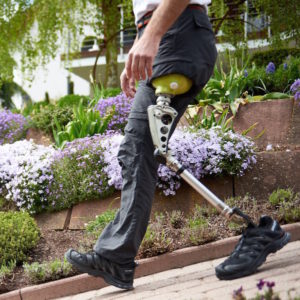| |
VGK |
3R80 |
C-Leg |
Genium |
| Manufacturer |
Orthomobility |
Otto Bock |
Otto Bock |
Otto Bock |
| Type |
Mechanical, with innovative autoadaptive fluidics control |
Mechanical |
Electronic |
Electronic, with more sensors than C-Leg, being able to adjust to more different situations |
| Swing phase control |
| |
VGK |
3R80 |
C-Leg |
Genium |
| Different walking speeds |
yes, slow to very fast |
yes, but not such a wide speed range. I haven’t found a setting supporting both very slow and very fast. |
yes, slow to fast |
yes, slow to very fast. |
| Effect of different shoe weight |
none. fluidic control adjusts automatically to different shoe weight |
bad. Heavier shoe means slower swing phase. Would require adjusting a screw setting to compensate |
bad. Havier shoe means slower swing phase. Would require different programming to adjust. |
none. Electronics compensates by adjusting the hydraulic unit automatically. |
| Natural walking style with knee bending and bouncing after heel strike |
yes, requires a bit of practice and a proper adjustment of the foot |
yes, requires a bit of practice and a proper adjustment of the foot |
yes, initial knee bending motion (before bouncing back) is damped smoothly |
yes, automatically having a few degrees of knee flexion on heel strike (Otto Bock calls it „pre-flex“ function) |
| Safety, preventing falling during sudden interruption of swing mode (stumbling) |
yes, stumble recovery function in swing mode |
no. Requires quick body reaction to prevent falling in stumbling situation. |
yes |
yes |
| Stance phase control |
| |
VGK |
3R80 |
C-Leg |
Genium |
| Safety, reliability of switching into stance mode, preventing falling in difficult situations on heel strike (e.g. stone under heel) |
yes |
depends. Requires very precise setting of the weight activation switch |
yes |
yes |
| Effect of additional weight, e.g. when bearing something |
none. Fludic control is able to compensate |
bad. Stance control is weight activated. Bearing additional weight could lead to stumbling |
none. Electronics compensates. |
none. Electronics compensates. |
| Effect of long descends or or long stairs down |
none. Fluidic control compensates. |
bad. The warmer the hydraulic unit gets, the more it looses its stance control function. |
OK. Electronics compensates by adjusting the hydraulic valves. However, due to the nature of the hydraulics, it might become too warm and then switch into a „safe mode“ with no knee bending function. |
OK, same as with C-Leg |
| Swing characteristics when not walking |
Stance control active. knee is relatively stiff. This is the price for having a “safe” knee, which does not bend unintentionally. |
OK. Swings almost freely, slightly damped by spring |
Bad. Stance control active, knee is relatively stiff |
Best. Knee swings freely. |
| Cycling Mode |
yes, to be activated with a small handle. With configurable knee resistance and security mode: In cycling mode, a quick movement of the knee will give sufficient stability to stand on a flexed knee. |
yes. Normal mode is fine for cycling. |
yes, to be activated with a special 3-times tipping on forefoot. Second mode characteristics can be configured. |
yes, to be activated with a remote control, or as with C-Leg. Multiple „second modes“ with configurable characteristics. |
| Aspects for every day usage |
| |
VGK |
3R80 |
C-Leg |
Genium |
| Maximum knee-angle |
perfect! Only restricted by the socket! With my short stump and socket, there is sufficient space so the knee can be bound to almost 175 degrees, which is the physiological kneeling angle of a sound leg. |
good! knee can be bound to 160 degrees |
bad. Only about 120 degrees, prothesis could feel like an obstacle, depending on the situation |
OK, much better than C-leg. |
| Kneeling down |
Well supported by a plastic knee cap that protects the floor and prevents slipping away |
Moderate. Weight is supported by plastic cover. However, the ottobock 3R80 logo gets scratches. With previous 3R80 model, foot goes up. |
OK, but only if knee protector is mounted. |
Very bad. Would slip away on hard floor and/or make scratches in knee frame or floor. |
| Weight |
heavy, 1400 g |
OK, 1200 g |
heavy, 1400 g |
Very heavy, 1600 g. Could be too much for a short stump |
| Water-proof |
yes! Can be used under shower, and even when doing water-sports. However, should not be used in salt water. |
Don’t know. Probably a few rain drops don’t matter.Update: The new version (2014) is waterproof! |
No! Must be kept away from any water! Moreover, Charge socket is located such that even a few rain drops could cause damage. |
Update 2014: The Genium X3 is waterproof (however: even heavier and more expensive than the standard Genium) |
| Handling |
nothing special |
nothing special |
Requires almost daily battery recharge, battery connector is a bit difficult to attach. |
Requires battery recharge every few days, however, battery connector is easy to attach |
| Restriction on the choice of prosthetic foot |
No restrictions. Can probably be used with any prosthetic foot of your choice |
No restrictions. |
Bad. Only allowed with a few Otto Bock feet, none of which are my personal preference |
Bad. Same as with C-Leg. |
| |
VGK |
3R80 |
C-Leg |
Genium |
 As an amputee having a short stump, a major requirement for my prosthetic leg is low weight of the prosthetic knee joint.
As an amputee having a short stump, a major requirement for my prosthetic leg is low weight of the prosthetic knee joint.